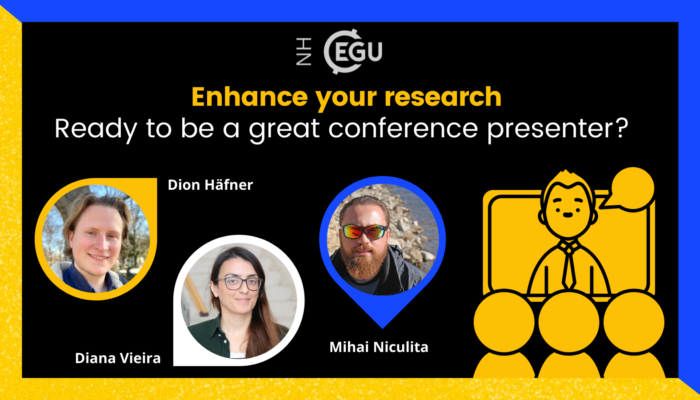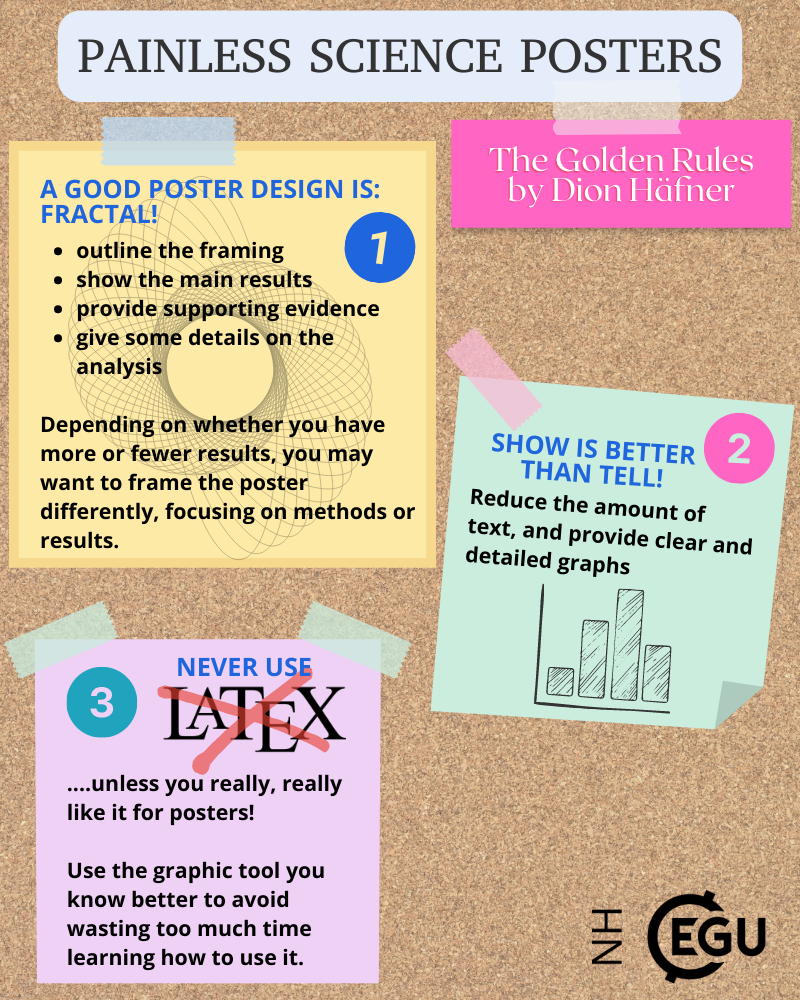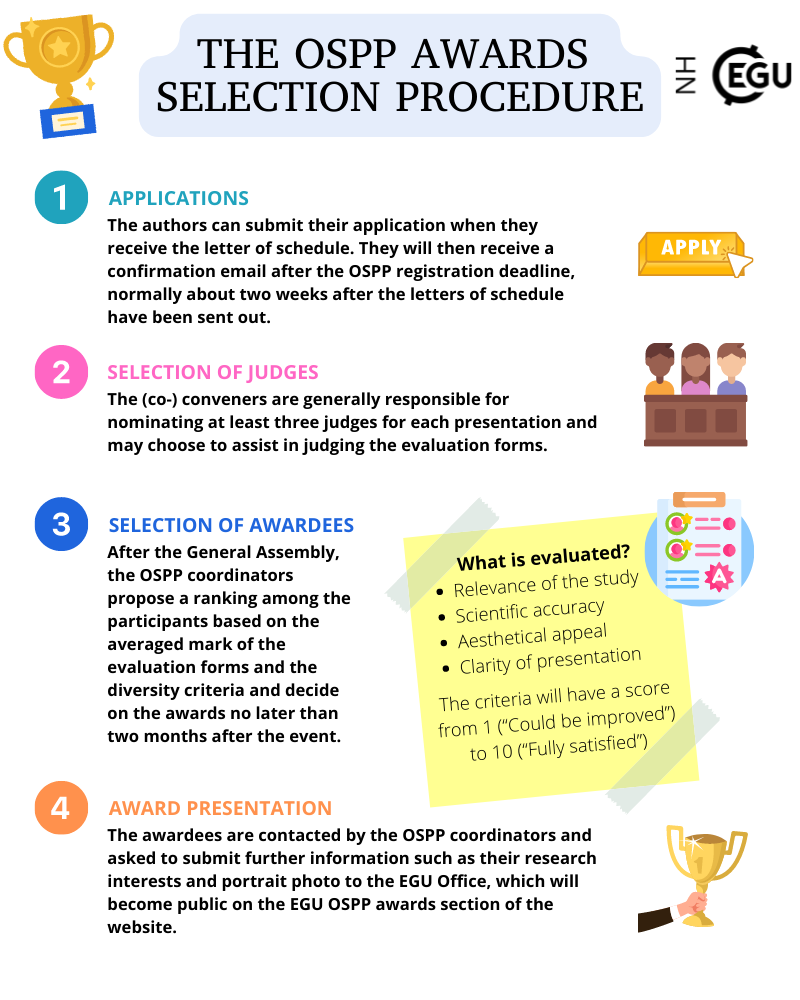
With the EGU General Assembly just around the corner, it’s time to pay special attention to how present your research, ideas, and messages to leave the best impression on a broad scientific community. However, it’s not always easy to stand out from the crowd at such big events and get people to notice you and remember your work. In the webinar organised by the ECS group of the EGU Natural Hazards (NH) Division earlier this month, two former EGU award-winning presenters, Dion Häfner, Ph.D. candidate in physical oceanography at the University of Copenhagen, and Dr. Diana Vieira, Researcher at the Joint Research Centre at the European Commission, shared their previous experience with EGU on how to design quality posters and plan engaging oral presentations. Their tips are applicable for any conference including the specific EGU presentation formats and participation in the EGU Outstanding Student and PhD candidate Presentation (OSPP) contest. The latter was explained by the third guest Mihai Niculita, Associate Professor in Geomorphology, Natural Hazards and Physical Geography at UAIC Iasi, and the EGU NH OSPP Coordinator.
Painless science posters
Posters are a formal way of communicating your work concisely and visually engaging. Their quality lies in the content transmitted, the relation between visualisations and content as well as design and the overall artistic impression. A well-presented poster can set you for success; it catches the attention of the moving audience, encourages them to follow your work, promotes your work through citations, and increases the possibility of a collaboration. However, if your poster is poorly presented, the audience can’t easily read and comprehend your work, and most likely, they won’t remember it after the event. The tragedy is that this can happen even if you have promising results to share.
But how to decide on the content and the level of details you should include in the poster? The key is to learn the lifecycle of a poster and make a poster that meets the requirements of each stage. First, your poster is usually presented in large halls, where you and others have an opportunity to meet and discuss your work. The advantage is that you are present next to your poster and can answer the questions, but on the other hand, the time is limited. Thus, aim at minimising the engagement time by presenting just enough information. But this is not the end; the next stage is when your poster is left in the hall without your presence, so your poster should also be standalone and appealing. Be mindful of the time you spend making your poster; after the event, the posters will be collected, likely thrown away, and won’t be used any longer.
Once you determine what to share, it’s time to design your poster. Follow the fractal design. Give more space to frame your research question and the main message. Then comes your main findings, evidence, and analysis details. The level of details you incorporate depends on your audience. Take any opportunity to visualise the information. Whether you turn a paragraph into a graph or replace software names with their logos, it all counts. Go for the simple and easy-to-use tools for making your poster. For instance, choose PowerPoint over LaTex unless you need to include many mathematical equations. Remember to infuse your personality into your poster, so design your poster according to your likes and preferences. Most importantly, don’t forget to enjoy the process!

3 golden rules provided by Dion Häfner to design painless science posters
Storytelling your research
As opposed to posters, where the audience has more time to focus on the specific aspects of your work based on their interests, in oral presentations, at least, for the most part, it is you who decide what they can focus on. With your narrative, you lead your listeners to understand your logic and perceive your work from your perspective. Thus, if you want to maintain their full attention till the end of the presentation, careful planning is a must.
The first element in planning an effective presentation is to know your audience. This determines what language you should use and how detailed the information should be. If your audience is researchers, feel free to use the technical vocabulary and explain the research question and the methods in-depth. If they are stakeholders, you should go easy on the technical terminology and more focus on the practical aspects of your research. For policymakers, make your take-home message bold and explain what that means for the society, and you’ll have their attention till the end of the presentation.
The second factor is to maintain the narrative cycle. Start with your research question and then answer how you approached it and what you achieved. But don’t stop here. You should explain the limitations of your work and the uncertainty it holds, and how it can address the research question. The narrative cycle is similar to the plot of the scientific publication, but here you are romanticising it to make it attractive and easy to remember.
Your next focus should be on the design of your presentation; structure, colour and format. Go for an organised, easy-to-follow set of slides and use colours to highlight and differentiate the information. But be moderate in changing colour combinations from one slide to another. Select the font and size that make your presentation more inclusive, but this also depends on where you are presenting your work, for example, in a classic conference (in person) or an online event.
So, the place where you give your presentation also matters. For instance, if you are giving a presentation at a classic conference, make sure that you maintain eye contact and don’t forget to breathe! In online presentations, test the presentation before the session, make sure that the slides can be easily read and, if you use a double screen, they are correctly connected. Depending on your audience, you can aim at an interactive presentation in a small meeting.
Lastly, practice, practice, and practice more! Keep the time. It shows you respect the audience and organisers. Check your voice! It is good to record and check your voice during your practice session, even if it is only for the first two slides. If your voice is unsteady or very low or loud, you can improve it significantly by breathing. Finally, be prepared for the potential questions and stay calm during the Q&A session.
What do we know about EGU OSPP awards and what to expect?
Each of the 18 EGU Divisions gives up to 6 OSPP awards to motivate the student participants and encourage improving the quality of the presentation. The EGU OSPP coordinator, who liaises with the EGU President and Officers decide who receives the award.
But who is eligible for the OSPP award? The current and recent BSc, MSc students, or Ph.D. candidates who received their conferral of degree not earlier than the 1 January of the conference year can take part in the competition. Only the first author and the presenter can register for the contest, and there is a limitation of one abstract per first author.

The 4 steps of the OSPP awards selection procedure
Given this year’s unique presentation format all registered participants, BSc, MSc students or PhD candidates compete for the award. While all researchers attending the General Assembly, who have earned a PhD or equivalent title, are invited to evaluate OSPP presentations as long as they are not participating in OSPP contest themselves and don’t have a conflict of interest with the presenters. The score-system evaluations are based on 1. content of the presentation, such as the relevance of the study and the scientific accuracy and 2. delivery which concerns aesthetic appeal and the clarity of the presentation. A score of 1 represents a further need for improvement, and a score of 10 means that the criteria were fully satisfied.
The EGU OSPP awards include a fee waiver for the next EGU General Assembly and an invitation to publish in one of EGU journals free of charge. The awardees also receive an award certificate at the next General Assembly.
Post edited by Silvia De Angeli
